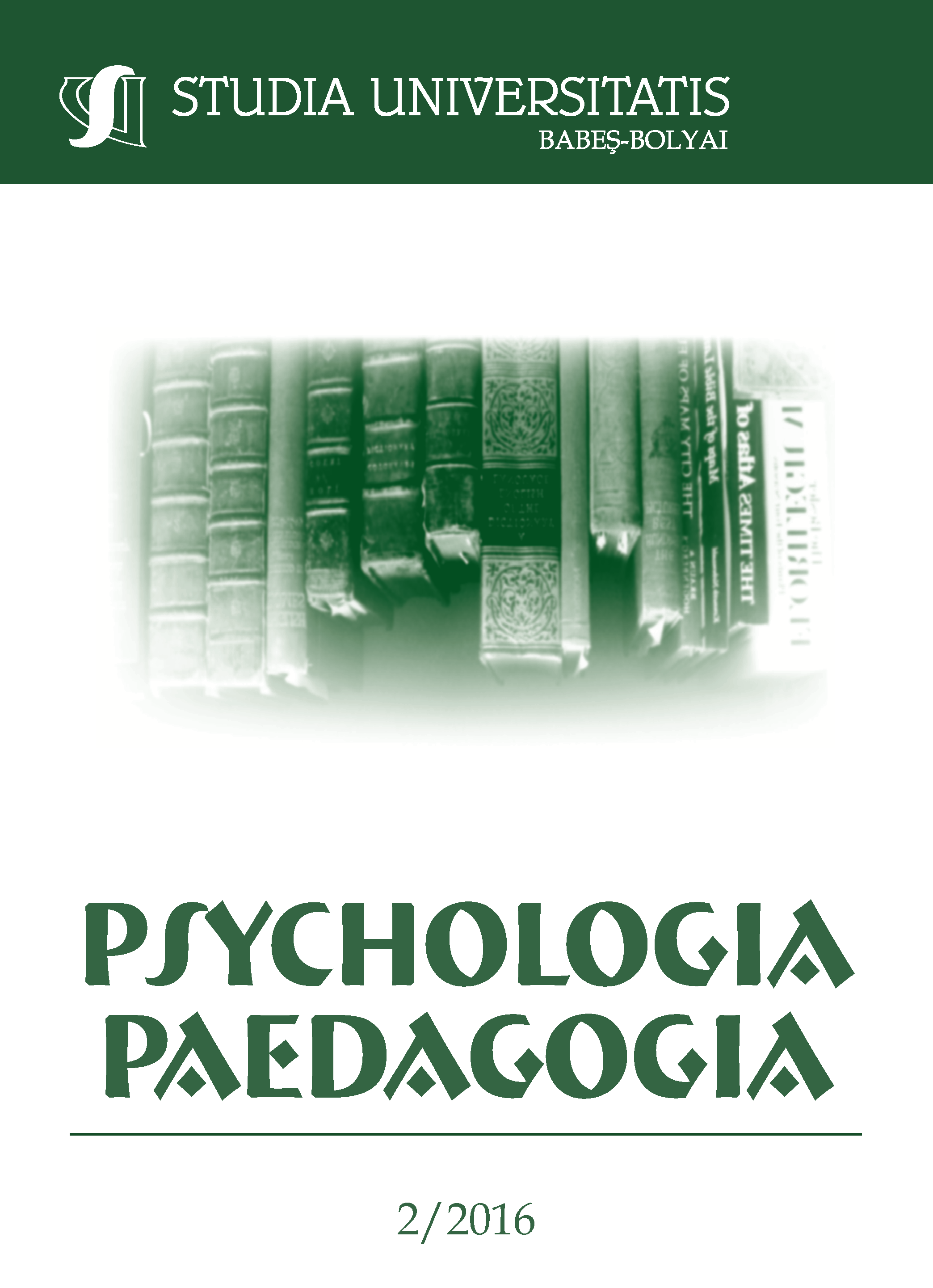WHAT FACTORS INFLUENCE THE DEVELOPMENT OF READING FLUENCY OF ROMA CHILDREN? THE EFFECTS OF WHOLE-CLASS REPEATED READINGS AND SCHOOL ABSENTEEISM
Keywords:
Roma; reading fluency; school attendance.Abstract
Research literature shows that Roma children’s literacy skills are less developed compared with their non-Roma peers. This situation represents a major deterrent in integration of Roma within the majority of countries of European Union. In this study we measured the effects of an intervention program aimed to diminish the gap in reading fluency skills between Roma and non-Roma 2nd grade children. The results indicated that a) Roma children’s performance was significantly lower than their non-Roma peers before and after the intervention, b) there was no difference in the reading fluency growth rate of Roma and non-Roma children and c) poor school attendance of Roma children moderated the effect of Roma ethnicity. The findings suggest that poor school attendance has a particularly significant negative effect on the development of reading fluency of children of Roma ethnicity.
Zusammenfasung. Die Forschungsliteratur zeigt, dass bei Roma-Kinder die Lese- und Schreibfähigkeiten weniger entwickelt sind im Vergleich zu ihren Nicht-Roma-Peers. Diese Situation stellt eine große abschreckende Wirkung auf die Integration der Roma in den meisten Ländern der Europäischen Union. In dieser Studie haben wir die Auswirkungen eines Interventionsprogramms gemessen, das darauf abzielt, die Lücke zwischen den Roma und Nicht-Roma-Kindern der 2. Klasse zu verringern. Die Ergebnisse zeigten dass, a) die Leistung den Roma-Kindern war signifikant niedriger als ihre Nicht-Roma-Kollegen vor und nach der Intervention, b) es gab keinen Unterschied in der Lesefluenz-Wachstumsrate von Roma und Nicht-Roma Kindern und c) schlechte Schulbesuch von Roma-Kindern moderiert die Wirkung von Roma-Herkunft. Die Ergebnisse deuten darauf hin, dass ein schlechter Schulbesuch einen besonders signifikanten negativen Effekt auf die Entwicklung der Lesefluenz von Kindern der Roma-Ethnizität hat.
Schlüsselwörter: Roma; Leseflüssigkeit; Anwesenheit.
References
Baucal, A. (2006). Development of mathematical and language literacy among Roma students. Psihologija, 39(2), 207-227.
Brüggemann, C. (2012). Roma Education in Comparative Perspective. Analysis of the UNDP/World Bank/EC Regional Roma Survey 2011. Roma Inclusion Working Papers. Bratislava: United Nations Development Programme.
Council of Europe (2006). Political and Legislative Framework for the Education of Roma Children: Reference Texts and Support Systems. Downloaded from https://sfi.usc.edu/education/roma-sinti/en/questioni-aperte/inclusione-sociale/il-diritto-alla-scuola/in-europa.php on December 16, 2016.
De Jong, P.F. & van der Leij, A. (2002). Effects of phonological abilities and linguistic comprehension on the development of reading. Scientific Studies of Reading, 6, 51-77.
Fundamental Rights Agency (2014). Education: The situation of Roma in 11 EU Member States. Luxembourg: Publications Office of the European Union.
Gottfried, M.A. (2010). Evaluating the Relationship between Student Attendance and Achievement in Urban Elementary and Middle Schools: An Instrumental Variables Approach. American Educational Research Journal, 47(2), 434-465.
Heilman, A.W., Blair, T.R., & Rupley, W.R. (2002). Principles and practices of teaching reading (10th ed.). Upper Saddle River, NJ: Merrill=Prentice Hall.
Herbers, J.E., Cutuli, J.J., Supkoff, L.M., Heistad, D., Chan, C., Hinz, E., & Masten, A.S. (2012). Early reading skills and academic achievement trajectories of students facing poverty, homelessness, and high residential mobility. Educational Researcher, 41(9), 366-374.
Kiprianos, P., Daskalaki, I. & Stamelos, G.B. (2012). Culture and the school: The degree of educational integration of Roma and Gypsies in the Peloponese region of Greece. International Review of Education, 58, 675-699.
Klauda, S.L. & Guthrie, J.T. (2008). Relationship of three components of reading fluency to reading comprehension. Journal of Educational Psychology, 100(3), 310-321.
Kosko, S.J. (2012). Educational attainment and school-to-work conversion of Roma in Romania: Adapting to feasible means or ends? Journal of Human Development and Capabilities: A multidisciplinary Journal for People-Centered Development, 13, 3, 415-450.
Kuhn, M.R., & Stahl, S.A. (2003). Fluency: A review of developmental and remedial practices. Journal of Educational Psychology, 95(1), 3-21.
Landerl, K. & Wimmer, H. (2008). Development of word reading fluency and spelling in a consistent orthography: An 8-year follow-up. Journal of Educational Psychology, 100(1), 150-161.
Meyer, M.S. & Felton, R.H. (1999). Repeated reading to enhance fluency: Old approaches and new directions. Annals of Dyslexia, 49, 283–306.
Morrisey, T.W., Hutchinson, L. & Winsler, A. (2014). Family income, school attendance and academic achievement in elementary school. Developmental Psychology, 50(3), 741-753.
National Reading Panel (2000). Teaching children to read: An evidence-based assessment of the scientific research literature on reading and its implications for reading instruction. (NIH Publication No. 00-4769) Washington, DC: U.S. Department of Health and Human Services, National Reading Institute of Child Health and Human Development.
O'Nions, H. (2010). Divide and teach: educational inequality and the Roma, The International Journal of Human Rights, 14:3, 464-489.
Rasinski, T.V., & Hoffman, J.V. (2003). Theory and research into practice: Oral reading in the school literacy curriculum. Reading Research Quarterly, 38, 510-522.
Rat, C. (2005) Romanian Roma, State Transfers, and Poverty. A Study of Relative Disadvantage, International Journal of Sociology, 35(3), 85-116.
Ready, D.D. (2010). Socioeconomic disadvantage, school attendance, and early cognitive development: The differential effects of school exposure, Sociology of Education, 83(4), 271-286.
Rumelhart, D.E. (1994). Toward an interactive model of reading. In R.B. Ruddell, M.R. Ruddell, & H. Singer (Eds.), Theoretical models and processes of reading (4th ed., p. 864–894). Newark, DE: International Reading Association.
Steward, R.J., Steward, A.D., Blair, J., Jo, H. & Hill, M.F. (2008). School attendance revisited: A study of urban African American students’ grade point averages and coping strategies. Urban Education, 43(5), 519-536.
Therrien, W.J. (2004). Fluency and comprehension gains as a result of repeated reading. Remedial and Special Education, 25, 252–261.
Therrien, W.J., & Kubina, R.M. (2006). Developing reading fluency with repeated reading. Intervention in School and Clinic, 41(3), 156-160.
Torgesen, J.K., Wagner, R.K., & Rashotte, C.A. (2012). Test of Word Reading-Efficiency, Second Edition (TOWRE-2). Austin, TX: Pro-Ed.
Downloads
Published
How to Cite
Issue
Section
License
Copyright (c) 2016 Studia Universitatis Babeș-Bolyai Psychologia-Paedagogia

This work is licensed under a Creative Commons Attribution-NonCommercial-NoDerivatives 4.0 International License.





